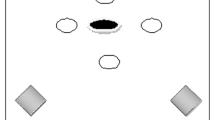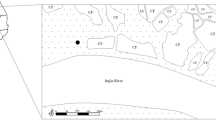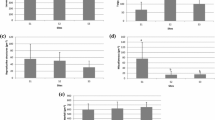Abstract
The present study was an effort to understand the amount of litter fall and its subsequent decomposition and quantify the release of available nutrients and soil physicochemical characteristics in plantations of four forest tree species (Lagerstroemia parviflora, Tectona grandis, Shorea robusta and Michelia champaca) in the Chilapatta Reserve Forest of the Cooch Behar Wildlife Division in the Terai zone of West Bengal, India. The most litter (5.61 Mg ha−1) was produced by T. grandis plantation and the least (4.72 Mg ha−1) by L. parviflora. The material turnover rate to the soil through decomposition from total litter was fastest during the first quarter of the year and subsequently decreased during the next two quarters. The material turnover rate was only 1 year, which indicates that more than 90% of the total litter produced decomposed within a year. The available primary nutrient content in litter varied across the four plantations over the year. The plantations generally did not significantly influence the soil physical characteristics but did significantly influence the availability of primary nutrients and organic carbon at two depths (1–15 and 16–30 cm) over the year. The availability of soil primary nutrients in the four plantations also increased gradually from the first quarter of the year to the third quarter and then decreased during the last quarter to the same level as in the first quarter of the year at both depths. The availability for soil organic carbon in the plantations followed a similar trend. The amount of litter produced and the material turnover in the soil in the different plantations differed, influencing the nutrient availability and organic carbon at the plantations. The amount of soil organic carbon was highest for T. grandis (2.52 Mg ha−1) and lowest for L. parviflora (2.12 Mg ha−1). Litter is the source of soil organic matter, and more the litter that is produced by the plantations, the higher will be the content and amount of soil organic carbon in the plantation.
Similar content being viewed by others
References
Ashton CE, Hogarth PJ, Ormond R (1999) Breakdown of mangrove leaf litter in a managed mangrove forest in Peninsular, Malaysia. Hydrobiology 413:77–88
Brown S, Lugo AE (1982) Storage and production of organic matter in tropical forest and their role in the global carbon cycle. Biotropica 14:161–187
Chacon N, Dezzeo N (2007) Litter decomposition in primary forest and adjacent fire-disturbed forests in the Gran Sabana, southern Venezuela. Biol Fertil Soils 43:815–821
Chakravarty DN, Barthakur BC (1997) Acid soils of Assam area and extent of acidity. In: Mahapatra IC, Mandal SC, Misra C, Mitra GN, Panda N (eds) Acid soils of India. Indian Council of Agricultural Research, New Delhi
Champion HG, Seth SK (1968) A revised survey of the forest types of India. Manager of Publications, New Delhi
Chavan KN, Kenjale RY, Chavan AS (1995) Effect of forest tree species on properties of lateritic soil. J Indian Soc Soil Sci 43:43–46
Contractor RM, Badnur VP (1996) Effect of forest vegetation on properties of a vertisols. J Indian Soc Soil Sci 44:510–511
Cuevas E, Brown S, Lugo AE (1991) Above and below ground organic matter storage and production in a tropical pine plantation and a paired broadleaf secondary forest. Plant Soil 135:257–268
Dadhwal VK, Shukla N, Vora AB (1997) Forest litter fall in India. A review and an estimate of litter fall and carbon flux. Indian For 123:45–52
Directorate of Forest (2001) 4th Working Plan for the Forests of Cooch Behar district and Jalpaiguri district (Part) Comprising Cooch Behar Forest Division and Cooch Behar S. F. Division, Vol I, 2000–2001 to 2009–2010. Divisional Forest Officer, Working Plans (North) Division, Darjeeling, West Bengal. Kolkata, India: Directorate of Forest, Govt. of West Bengal, p 87
Haase R (1999) Litter fall and nutrient return in seasonally flooded and non-flooded forest of the Pantanal, Mato Grosso, Brazil. For Ecol Manag 117:129–147
Hagen-Thron A, Callesen I, Armolaitis K, Nihlgard B (2006) The impact of six European tree species on the chemistry of mineral topsoil in forest plantations on former agricultural land. For Ecol Manag 195:373–384
Hashimoto T, Miura S, Ishizuka S (2009) Temperature controls temporal variation in soil CO2 efflux in a secondary beech forest in Appi Highlands, Japan. J For Res 14:44–50
Hossain M, Fazlul-Hoque (2008) Litter production and decomposition in mangroves: a review. Indian J For 31:227–238
Jackson ML (1967) Soil chemistry analysis. Prentice Hall of India Pvt. Ltd., New Delhi
Jerabkova L, Prescott CE, Kishchuk BE (2006) Nitrogen availability in soil and forest floor of contrasting types of boreal mixed wood forests. Can J For Res 36:112–122
Jha MN, Gupta MK, Dimri BM (1999) Soil organic matter status under different social forestry plantations. Indian For 125:883–890
Jha MN, Gupta MK, Saxena A, Kumar R (2003) Soil organic carbon store in different forest in India. Indian For 129:715–724
Johnston AE (1986) Soil organic matter; effects on soil and crops. Soil Use Manag 2:97–105
Ke X, Zhao LJ, Yin WY (1999) Succession in communities of soil animals during leaf decomposition in Cyclobalanopsisglauca forest. Zool Res 20:207–213
Koul DN (2004) Carbon sequestration estimates of various land uses in Terai Zone of West Bengal. M. Sc. Thesis. Uttar Banga Krishi Viswavidyalaya, Pundibari, West Bengal, PP 59–60
Langusch J, Broken W, Armbruster M, Diese N, Matzner E (2003) Canopy leaching of cations in central European forest ecosystems: a regional assessment. J Nutrient Soil Sci 166:168–174
Lodhiyal LS, Lodhiyal N, Singh SK (2002) Litter dynamics and nutrient return of poplar plantations in moist plain areas of central Himalayas. Indian J For 128:1183–1194
Mfilinge PL, Meziane T, Bachok Z, Tsuchiya M (2005) Litter dynamics and particulate organic matter outwelling from a subtropical mangrove in Okinawa Island, South Japan. Estuar Coast Shelf Sci 63:301–313
Pande PK (1999) Comparative vegetation analysis and Sal (Shorea robusta) regeneration in relation to their disturbance magnitude in some Sal forests. Trop Ecol 40:51–61
Pande PK (2001) Litter nutrient dynamics of Shorea robusta Gaertn. plantations at Doon Valley (Uttaranchal), India. Indian For 127:980–994
Pande PK, Sharma SC (1993) Litter decomposition in some plantation (India). Ann For 1:90–101
Pande PK, Meshram PB, Banerjee SK (2002) Litter production and nutrient return in tropical dry deciduous teak forests of Satpura Plateau in central India. Trop Ecol 43:337–344
Pastor J (1987) Successional changes in nitrogen availability as a potential factor contributing to spruce declines in boreal North America. Can J For Res 17:1394–1400
Paudel S, Sah JP (2003) Physiochemical characteristic of soil in Sal (Shorea robusta) forests in eastern Nepal. Himal J Sci 1:107–110
Polyakova O, Billor N (2007) Impact of deciduous tree species on litter fall quality, decomposition rates and nutrient circulation in pine plantations. For Ecol Manag 253:11–18
Prescott CE (2002) The influence of the forest canopy on nutrient cycling. Tree Physiol 22:1193–1200
Raina AK, Jha MN, Pharasi SC (2001) Forest soil: vegetation relationship in Mussoorie forest division (Uttaranchal). Indian For 127:883–890
Rajagopal K, Buvaneswaran C, Subramanian V, George M (2005) Nutrient cycling in young teak plantation I-Restitution of nutrients through litter and rain wash. Indian For 131:221–228
Rawat RS (2005) Studies on interrelationship of woody vegetation, density and soil characteristics along an altitudinal gradient in a montane forest of Garhwal Himalayas. Indian For 131:991–995
Ren YH, Cao M, Tang JW, Zhang JH (1999) A comparative study on litter fall dynamics in a seasonal rain forest and a rubber plantations in Xishuangbanna, SW China. Acta Phytoecol Sin 23:418–425
Sá JCM, Cerri Carlos C, Warren AD, Rattan L, Solismar P, Venske F, Piccolo MC, Brigitte EF (2001) Organic matter dynamics and carbon sequestration rates for a tillage chronosequence in Brazilian Oxisol. Soil Sci Soc Am J 65:1486–1499
Scott NA, Binkley D (1997) Foliage litter quality and annual net N mineralization: comparison across North America forest site. Oecologia 111:151–159
Shadangi DK, Nath V (2006) Litter decomposition in eucalyptus and pines plantations and natural Sal forests related to micro-arthropods in different season in Amarkantak, Madhya Pradesh. Indian For 132:420–428
Sheikh MA, Kumar M (2010) Nutrient status and economic analysis of soils in oak and pine forests in Garhwal Himalaya. J Am Sci 6:117–122
Singh JS, Gupta SR (1977) Plant decomposition and soil respiration in terrestrial ecosystems. Bot Rev 43:449–528
Singh G, Rathod TR, Chouhan S (2004) Growth, biomass production and the associated changes in soil properties in Acacia tortilis plantation in relation to plantation density in Indian arid zone. Indian For 130:605–614
Swift MJ, Heal OW, Anderson JM (1979) Decomposition in terrestrial ecosystems. Studies in Ecology, vol 5. University of California Press, Berkeley, USA, pp 46–87
Upadhyay SD, Singh VP (1981) Microbial turnover of organic matter in litter decomposition in semi-arid grassland. Pedobiologia 21:100–109
Varshney VK, Garg RK (1996) Litter production pattern in Albizia lebbeck plantation stand at Hissar. Indian For 122:813–816
Vitousek PM, Sanford RL Jr (1986) Nutrient cycling in moist tropical forest. Ann Rev Ecol Syst 17:137–167
Wang J, Huang JH (2001) Comparison of major nutrient release patterns in leaf litter decomposition in warm temperate zone of China. Acta Phytoecol Sin 25:375–380
Woomer PL (1999) Impact of cultivation of carbon fluxes in woody savannas of Southern Africa. Water Air Soil Pollut 70:403–412
Zhang QF, Song YC, Wu HQ, You WH (1999) Dynamics of litter amount and its decomposition in different successional stage of evergreen broad-leaved forest in Tiantong, Zhejiang, Province. Acta Phytoecol Sin 23:250–255
Zhang ZS, Li XR, Liu LC, Jia RL, Zhang JG, Wang T (2009) Distribution, biomass and dynamics of root in revegetated plantation of Caraganakorshinskii in the Tengger Desert, northwestern China. J Plant Res 122:109–119
Author information
Authors and Affiliations
Corresponding author
Additional information
The online version is available at http://www.springerlink.com
Corresponding editor: Zhu Hong.
Rights and permissions
About this article
Cite this article
Shukla, G., Pala, N.A. & Chakravarty, S. Quantification of organic carbon and primary nutrients in litter and soil in a foothill forest plantation of eastern Himalaya. J. For. Res. 28, 1195–1202 (2017). https://doi.org/10.1007/s11676-017-0394-7
Received:
Accepted:
Published:
Issue Date:
DOI: https://doi.org/10.1007/s11676-017-0394-7




